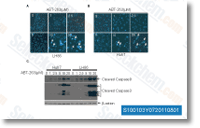Identification of your components that comprise sig nalling cascades controlling dimorphism in Sporothrix schenckii is of distinct interest in our laboratory for years. Learning the mechanisms controlling dimorph ism in S. schenckii is important for comprehending its patho genicity along with the response towards the hostile setting encountered inside the host, Dimorphism in S. schenckii as in other pathogenic fungi continues to be linked with viru lence, This fungus exhibits mycelium morphology in its saprophytic phase at 25 C and yeast morphology in host tissues at 35 37 C. Scientific studies to the part of calcium in S.
schenckii dimorphism showed that calcium stimulates the yeast to mycelium transition and that calcium uptake accompanies this transition, Calcium is probably the most critical intracellular sec ond messengers and is concerned in a wide range of cellu lar events in many eukaryotic cells, Calcium can influence cellular processes by binding to calmodulin selleck inhibitor that in turn activates Ca2 calmodulin dependent protein kinases, These serine threonine protein kinases have two significant domains. a very conserved amino terminal catalytic domain plus a carboxy terminal regulatory domain. The regulatory domain consists of the autoinhibitory and Ca2 CaM binding domains. The autoinhibitory domain acts as a pseudosubstrate, block ing access on the catalytic site, Ca2 calmodulin binding for the regulatory domain leads to a conforma tional change in Ca2 CaM kinases exposing the catalytic domain by getting rid of the autoinhibitory domain.
This permits the binding within the substrate and its subsequent phosphorylation, The Ca2 calmodulin kinases constitute a relatives of linked kinases that involves CaMKK, myosin light chain kinase and CaMKI to CaMKIV. The part of CaMKs in mammalian techniques, especially in neurons is effectively estab lished, even though their presence going here and purpose in fungi is simply not absolutely documented. CaMKs are described for Sac charomyces cerevisiae, Aspergillus nidulans, Schizosaccharomyces pombe and Neurospora crassa, amongst other folks. Complete genome sequencing projects also demonstrate the presence of hypothetical proteins homolo gous to CaMK in lots of other fungi. In S. cerevisiae, the CaMKs function from the survival of pheromone induced development arrest, salt tolerance and thermotolerance, In the filamentous fungus A.
nidulans, the disruption  in the CaMK encoding genes, CMKA and CMKB was reported for being lethal, On this fungus, CaMK is needed for progression through the nuclear division cycle, In S. schenckii, we described a CaMK encoded through the sscmk1 gene, The SSCMK1 cDNA encoded a protein of 407 amino acids using a calculated molecular excess weight of 45. six kDa. The analy sis with the derived amino acid sequence unveiled a calcium calmodulin kinase containing the twelve conserved sub domains vital for a practical serine threonine protein kinase in addition to a serine threonine protein kinase catalytic domain.
in the CaMK encoding genes, CMKA and CMKB was reported for being lethal, On this fungus, CaMK is needed for progression through the nuclear division cycle, In S. schenckii, we described a CaMK encoded through the sscmk1 gene, The SSCMK1 cDNA encoded a protein of 407 amino acids using a calculated molecular excess weight of 45. six kDa. The analy sis with the derived amino acid sequence unveiled a calcium calmodulin kinase containing the twelve conserved sub domains vital for a practical serine threonine protein kinase in addition to a serine threonine protein kinase catalytic domain.
Beta Amyloid Signal
Aβ molecules can aggregate to form flexible soluble oligomers which may exist in several forms.
